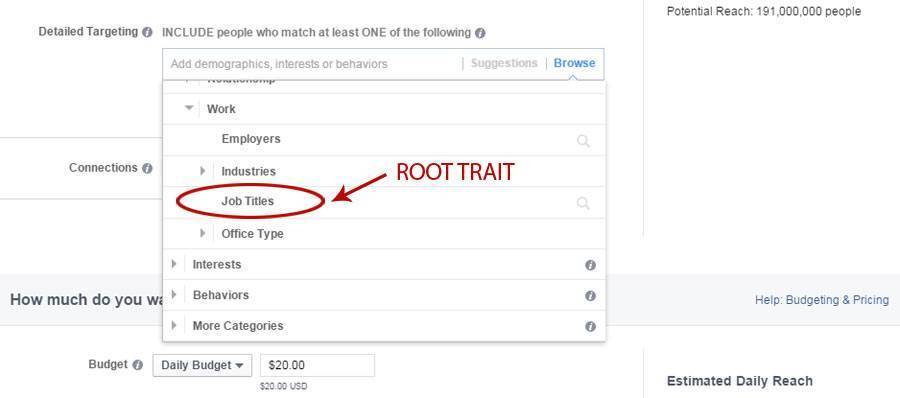

Persona Research with Facebook Audiences
Before the Internet, advertising agencies developed personas to decide which magazines, publications and TV shows to run ads for their clients.
In the context of the digital age, very little has changed. Advertising agencies still use personas to inform their strategies, but rather than magazines, personas help us select what websites and keywords to target in our online advertising.
It isn't just the medium that has changed -- the process agencies use to create personas have also changed. In the past, businesses would pay for expensive consumer research studies to learn insights about their products and customers. In today's world, we have demographic and psychographic information available at our fingertips with the help of Facebook. It is this unique quality of Facebook that we will dedicate today's blog post to.
Let's begin by exploring what makes Facebook such a great tool for researching personas.
What's so special about Facebook targeting?

The fractured nature of modern media has been both a boom and a boon for personas. The narrow specialization of many publications means that advertisers can precisely target their intended audience by selecting the media outlet whose demographic matches their target demographic. This means it is more important than ever to understand your customer.
Conversely, the specialization of modern media is limiting because the content only appeals to one aspect of the intended audience, and therefore the advertising can only appeal to one aspect of the buyer persona (ie. I know my audience likes gardening, so therefore I'll advertise in Home & Garden magazine).
Digital advertising strategies like Google Adwords offer targeting options that are an improvement over traditional tactics, but they still largely only appeal to one root trait of the buyer persona. We can narrow that targeting with geographic targeting, but the only trait that shapes the size of our audience is "keyword".
Facebook is different because the specialization that limits our previous tactics doesn't exist. Facebook has data on all of us. Our age, education level, interests, job titles, etc. were all freely offered to advertisers the instant we signed up. And whether you choose to advertise on Facebook or not, this information can be openly mined to help you better understand your customer.
To illustrate how to accomplish this, let's create some hypothetical personas and decide how we would go about targeting them.
Persona Creation
Tech Influencers

Technology has transformed our society in more ways than we can count. Tech journalists are on the front line of this revolution, bringing news of innovation to the masses. For this reason, tech journalists hold a lot of influence and great rewards await the businesses that peak their interests.
Who might use this persona: Electronics Manufacturers, App Developers, Advertising Agencies
Overworked Client Executives
 Client executives and sales managers have a tough gig. They are often the voice of the customer to internal stakeholders and the voice of the company to outside stakeholders. This puts them squarely in the crosshairs of both parties when something goes wrong. Add in a house mortgage and a small family and you have a recipe for an over-worked and under-rested individual.
Client executives and sales managers have a tough gig. They are often the voice of the customer to internal stakeholders and the voice of the company to outside stakeholders. This puts them squarely in the crosshairs of both parties when something goes wrong. Add in a house mortgage and a small family and you have a recipe for an over-worked and under-rested individual.
Who might use this persona: Yoga instructors, Masseuses, Spas, Spirits & Alcohol Brands, Stress Ball Manufacturers
Off-Gridders
 Anyone who pays regular utility bills can relate to the desire to cut ties. There are thousands of Americans who given the option would prefer less dependence on the grid. Those that are most likely to act on these feelings could be described as blue-collar; belonging to a building trade or worker's union. They are likely to have some propensity and enthusiasm for DIY projects and feel pride from being self-sufficient.
Anyone who pays regular utility bills can relate to the desire to cut ties. There are thousands of Americans who given the option would prefer less dependence on the grid. Those that are most likely to act on these feelings could be described as blue-collar; belonging to a building trade or worker's union. They are likely to have some propensity and enthusiasm for DIY projects and feel pride from being self-sufficient.
Who might use this persona: Solar Companies, Tiny Home Builders, Tool Manufacturers
Targeting the Personas
Step 1: Identify the Root Trait
For a persona to make sense, there must be one trait that is shared by all members within it. We call this trait, the "root" trait and it will serve as the foundation for our targeting.

In our experience, one of the best root traits to target (especially for B2B companies) is job title. If you are selling B2B, chances are you have an idea of the specific job titles you need to reach with your advertising. Referring to the 3 personas we created above, the job titles we might target include:
- Tech Influencers - Contributing Editor, Editor in Chief, Journalist, Writer/Blogger, Content Specialists, etc,.
- Overworked Client Executives - Client Executive, Client Manager, Sales Manager, Account Manager, etc,.
- Off-Gridders - Carpenter, Plumber, Contactor, Welder, etc,.
At this point, your audience is much too broad. We need to focus our efforts and shrink the audience by adding more traits to our persona research.
Step 2: Narrow your focus with additional traits
What else do you know about your audience? Facebook has hundreds of demographic and pyschographic traits to further segment your customer. Areas to consider are:
- Demographics - How old is your customer? What state do they live in? What language do they speak? What is their household income? What is their education level?
- Interests - What Facebook pages do they like? Music preference? Movie titles or books? Pop-culture references?
- Technology - What technology do they use? Do they display a certain brand preference? Are they more likely to use a phone or desktop to view Facebook?
- Health - Do they care about health and fitness? What sort of activities do they participate in to stay healthy?
- Food and Beverages - What do they eat? What do they drink? What brands do they show support for?
- Professional - Where do they work? What is their job title (In this case, the root trait)? Do they belong to any professional organizations?
- Travel - How often do they travel? How do they prefer to travel?
- Politics - Where do they fall on the political spectrum? Do they lean in one direction?
Before we move on to step 3, let me walk through my rationale for our three personas:
- Tech Journalists - Though not included our description, we chose to limit our selection to individuals in the United States within the age range of 23-65+. We started our selection with the root trait, creating a list of every conceivable job title associated with media influencers. With our root trait established, we narrowed our selection to tech journalists by adding the requirement that they must also like the large tech blogs and magazines.
- Overworked Client Executives - Once again, we began with the root trait of job title, compiling a list of synonyms for client executives. We narrowed our selection geographically to the United States and demographically by age 21-35. We further narrowed our selection by specifying that they must also be parents with children between the ages of 0-5 years. Finally, we segmented for those individuals seeking stress relief by including the interests of yoga, meditation and alcohol.
- Off-Gridders - Starting with the root trait of a blue collar worker, we created a list of titles for laborers such as plumber, carpenter and welder. We then added the interest of DIY projects, homesteading, and Off Grid magazine.
After completing this step with our three personas, we were left with the following audience selections:

Step 3: Add/exclude additional traits to achieve your potential reach
Although we didn't need to in any of our examples, if your potential reach is either too large, you can shrink it further by excluding people with new traits or by adding more traits. If it happens to be too precise, you can broaden it by adding more insights to your existing traits.
Step 4: Design creative to appeal to your targeted persona
The final step before going live with your campaign is to design creative and messaging that appeals to your target personas. But that is a topic we'll save another day. Part two to come soon.




